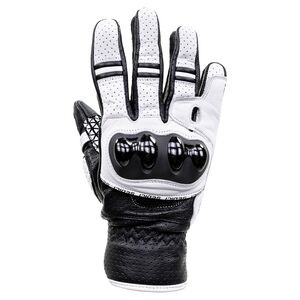You asked for it. A Ninja showdown — the upstart ZX-4RR versus the veteran ZX-6R. Which one is the better choice?
It’s a loaded question of course. “Better” in what sense, and for whom? It is a question that popped up several times while I was at the 2024 ZX-6R launch last month. It put into motion a cascade of curiosities for my colleagues and I. So much so that a few weeks later my van was filled to the brim with the neon green of the two Ninja siblings.

It’s worthwhile to get better acquainted with both the ZX-4RR and the ZX-6R in the respective first ride reviews. Initial impressions would leave one to believe that the 4RR is a “mini-supersport,” just like the 6R in every way except miniaturized. Riding both bikes back to back, however, challenged that over-simplified presumption.
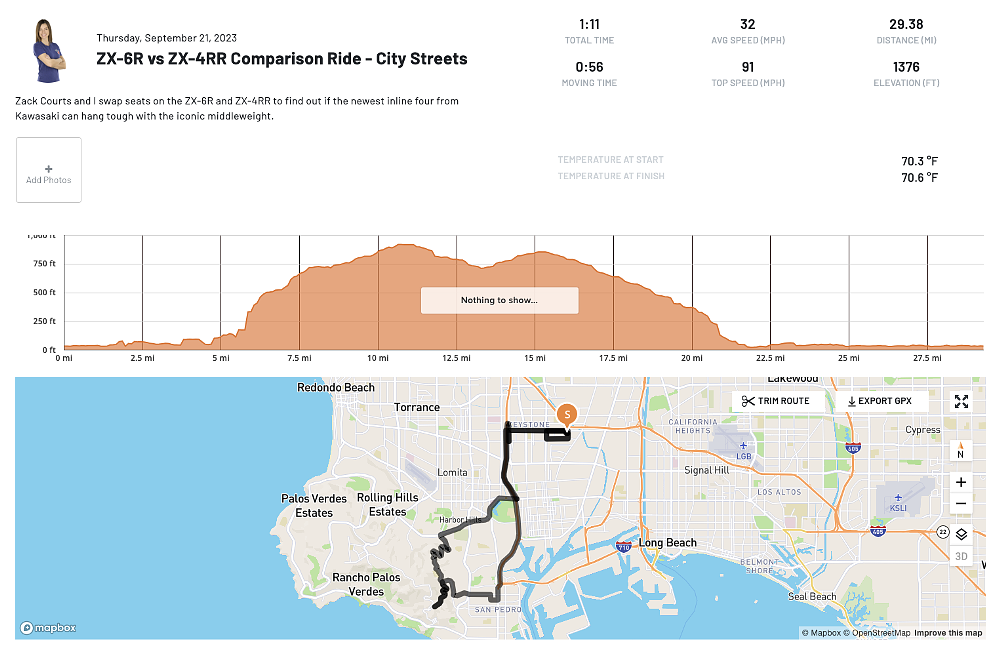
Ergonomics
One of the most surprising findings in this comparison ride was how much more comfortable the ZX-4RR is. Even for my taller colleagues, we were unanimous that the ZX-4RR was a more relaxed riding position. It flies in the face of the conventional wisdom that larger displacements make for a roomier cockpit.
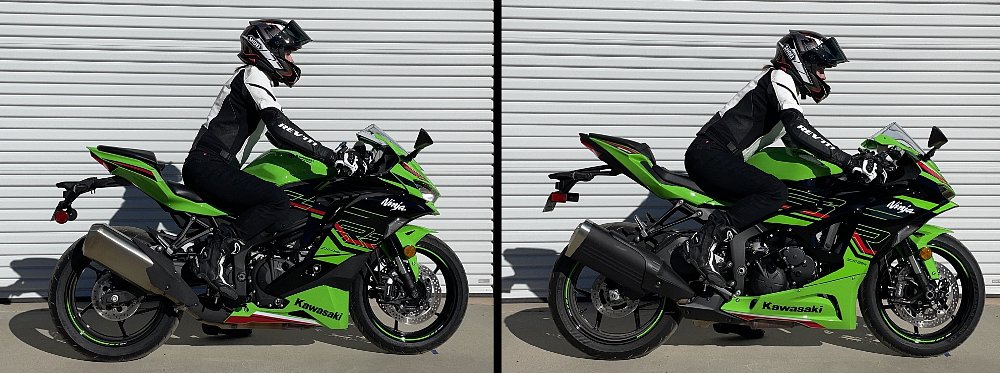
The 4RR takes cues from its popular parallel-twin brother, the Ninja 400, using “raised” clip-ons (meaning they rise above the triple clamp) and a lower footpeg setting to neutralize the sport-riding position. The 6R, however, makes no compromises. True clip-ons (meaning they dip below the triple clamp) and a high rear set for the footpegs fold the rider into the unforgiving attack position.

As far as approachability goes, the 4RR has a seat height that is 1.2 inches lower than the 6R's. For riders on the short side of the spectrum, that can make a huge difference in the ability to get a foot down or not.

In the comfort department, it really is no contest. The ZX-4RR is by and large the more accommodating of the two for street riding. The aggressive riding position of the ZX-6R may work better for extreme lean angles of spirited sport riding on or off the track, but for the everyday ride, I found myself gravitating towards the micro Ninja most often.
First tally: ZX-4RR 1, ZX-6R 0.

Power
There is no replacement for displacement. That overused cliché is hard to argue against in this case study. While Kawasaki doesn’t post any horsepower claims on its website, the internet is full of figures and dyno charts. Going by the consensus, the ZX-6R has nearly twice the horsepower of the 4RR.
That difference in power is shocking to see in real-time. Zack Courts and I devised multiple rpm roll-on tests to gauge the disparity, trying to find a sweet spot where the 4RR might actually cause the 6R to break a sweat. Try as we may, the 6R absolutely crushed the 4RR for sheer power and speed in every scenario.
I was holding on to the delusion that because the 4RR was an inline four cylinder as well, and remarkably faster than the Ninja 400, that it would somehow keep the 6R in sight during these sprint tests. It was all there on paper, easy enough to see, but the direct comparison on the street ride was the real eye opener.
As a consolation, the ZX-4RR displayed more speed and overtaking capability than the Ninja 400. It’s a complaint I make loudly and often about most lightweight bikes in the 500 cc and under category. Being able to squirt into safe space bubbles, out of blind spots, and to overtake cars while doing 65 mph plus in traffic is a must-have for me personally, and the 4RR delivered.
Updated tally: ZX-6R 1, ZX-4RR 1.
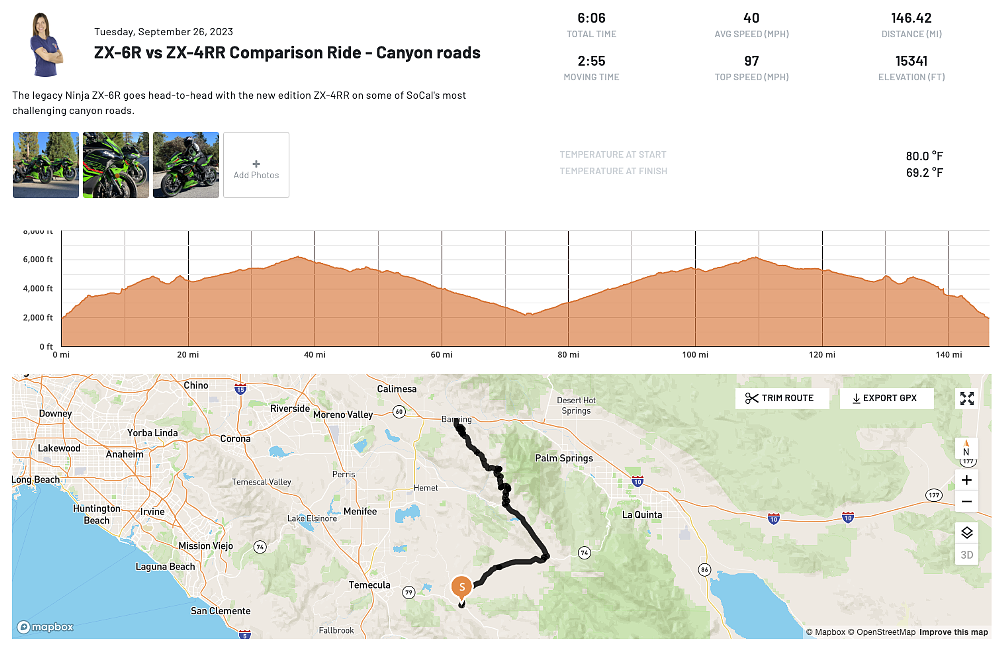
Handling
It is difficult to proclaim a winner here as both of the Ninjas faithfully uphold their racing pedigree. On brakes, suspension, and chassis, I believe each first ride review paints an accurate picture that both these bikes are demonstrably good, extremely good even. But how do they compare?
The ZX-6R behaved like a caged beast on the canyon roads. It took a controlled and steady hand to keep the power in check for the tight “S” curves, and the bike hummed with pent-up energy. I had to gather up the reins for corner entry, but on corner exit the 6R was a thrill to unleash. Even if I wasn’t revving to its peak performance at high rpm, the mid-range on the 6R was still plenty adequate to deliver an adrenaline rush dashing out of the corner. The suspension is stiffer on the 6R compared to the 4RR, at least for my derriere, but was no hindrance to its performance. What was noticeable was the fatigue I felt after hustling the 6R down a choice mountain pass. Was it the effort of using double the amount of brakes against gravity? Was it the weight of the bike? The high-and-tight riding position? Or the constant vigilance in keeping the 6R power in check? Whatever it was, the same level of fatigue was reported by my riding partner. Perhaps because of all the reasons listed before, the 6R just feels more tiring than the 4RR.

And so that brings me to the little Ninja that can. The 4RR was a well balanced tool for canyon carving. It was light and nimble in the corners and was more carefree in its character compared to the pent-up rage of the 6R. I don't want to belie the sporty nature of the 4RR, however. It can still be aggressive in its cornering. It just does so without the tension of the corked-up power of the 6R.
In fact, the 4RR did slightly suffer from the opposite problem in that it was hard to pinpoint a “happy place” in the power band. One gear too high, and the 4RR was sluggish coming out of the corner. Go down a gear, with the mini inline-four screaming anywhere from 12,000 to 14,000 rpm, and it would deliver a much more satisfying pounce out of the corners, but it was extra twitchy mid-corner. It was a constant dance with the 4RR, trying to find what gear and rpm would hook up the best for every single corner, whereas the 6R could be a little bit more forgiving when lugging the engine a gear too high.
This leaves me with a draw in the handling category. The strengths and weaknesses of each green machine cancel one another out. Final tally is two points awarded to each of the Ninjas, so some tie-breakers need to be called into action.
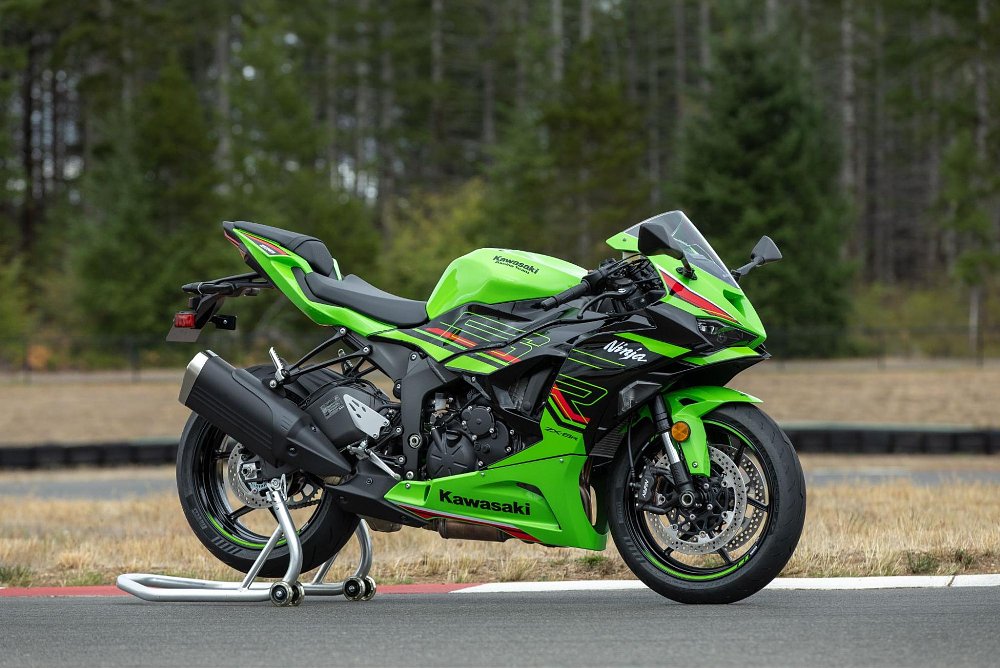
Club racers and horsepower addicts: ZX-6R category winner
Do you do a lot of freeway commuting? Do you roll with a group of riders on 600 cc or 1,000 cc sport bikes? Are you into club racing at your local track?
Yes to any of the above and I would recommend the ZX-6R over the 4RR. Power-hungry riders will not be pleased with what the 4RR is offering, even if you find the newer model exciting. The 6R rightly maintains its dominance as the true middleweight here, and the 4RR won’t eat up the highway miles or keep up with your pals on bigger bikes.

For club racers, the 6R is still a more logical choice. Would the 4RR be a hoot on the track? For sure. Does it currently have a clearly defined racing class to run in (and be competitive in), along with support and a deep aftermarket parts catalog? Decidedly not. I am sure that is going to evolve and change, but as of this writing the 6R still has more to offer the club racer.

If you are a sport bike enthusiast and willing to overlook the pain of a dedicated sport riding position in exchange for “moar powah,” the ZX-6R is still your best option.
Sport rider enthusiast and track-day junkie: ZX-4RR category winner
Have you lusted over vintage Japan-only models like the Kawasaki ZX-R 250, Suzuki GSX-R250 from the late 1980s, and Yamaha FZR250R? Do you ride track days and want the perfect compromise between a full-bore 600 cc and the Ninja 400? Are you a newer yet confident street rider who wants something that's a step up from the usual 250-to-400 cc fare?

The ZX-4RR is it. If I had a nickel for every time someone asked me, "When will we finally get one of the cool micro inline fours in the U.S.A?” then I could buy… well, at least a soda, in this economy. For many of my sport-riding buddies over 40, there is a lot of hype around the 4RR, the mythic inline four they could never get stateside. Track-day riders will enjoy many of the up-spec perks of the four-cylinder micro machine, and probably save a bunch of tire money compared to their middleweight brethren. If your local roadracing circuit is on the shorter and more technical side, the 4RR will be an excellent companion on your knee-dragging adventures. How might the 4RR racing scene shape up? It’s hard to say, at this point, but racing organizations are taking notice.
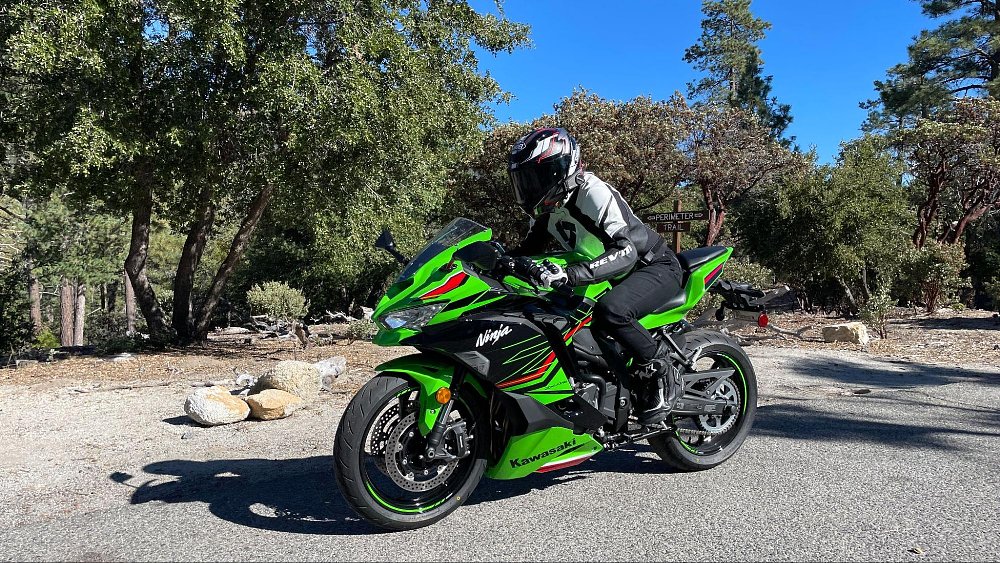
For the street rider, the 4RR offers a very enticing proposition. Top-notch sport bike aesthetics? Check. Comfortable “sport casual” riding position? Check. Power and performance capability that is still exciting and gentle enough that it could be a first bike for some riders and a second bike for others? Big check mark. The only hang up here will be the price point, of course. The ZX-4RR starts at $9,899 for 2024 ($9,399 for the single-R version) while the parallel-twin Ninja 400 is significantly cheaper at $5,299 for 2024 (but significantly less fun, at least from this rider’s perspective). The price gap is severe but the 4RR is truly from the ground-up an all-new design, and it brings top-class performance to the otherwise anemic beginner bikes of the class. You get what you pay for.
Which one would I choose? Since I already have a 600 cc sport bike in the garage, I would be tempted to welcome the hot new Ninjette into the stable. The ZX-4RR is well balanced for the usual riding demands I would put on it, being that I live in the heart of San Diego’s best canyon roads. As a petite rider, I appreciate its size and weight, too. As much fun as the ZX-4RR likely is on the circuit, I sincerely doubt it could unseat my current middleweight race bike from that throne. When I lock eyes on the corner exit and pin it, I want to feel that explosion of power, maybe even get a little slide from the rear wheel, and rocket down the straightaway with more speed left on tap than I have nerve. As peppy as the ZX-4RR is, I know full well from the roll-on tests it can’t deliver on that.
So, which one is better? The ZX-6R or the ZX-4RR? Each rider should have a different answer to that one, depending on their wants and needs. All I know is that the introduction of the ZX-4RR makes it a much harder decision to make, and in a good way.
| 2024 Kawasaki ZX-6R | 2023 Kawasaki Ninja ZX-4RR | |
|---|---|---|
| Price (MSRP) | $11,299; $12,299 with ABS | $9,699 |
| Engine | 636 cc, liquid-cooled, DOHC, 16-valve, inline four cylinder | 399 cc, liquid-cooled, 16-valve, inline-four |
|
Transmission, final drive |
Six-speed, chain | Six-speed, chain |
| Claimed horsepower | NA | NA |
| Claimed torque | NA | NA |
| Frame | Aluminum perimeter | Steel-tube trellis |
| Front suspension | Showa Separate Function Fork-Big Piston, 41 mm inverted cartridge-type fork, adjustable for preload, stepless compression and rebound damping; 4.7 inches of travel | Showa SFF-BP 37 mm fork, adjustable for spring preload; 4.7 inches of travel |
| Rear suspension | Uni-Trak with adjustable preload, 25-way rebound damping, stepless high- and low-speed compression damping, adjustable ride height; 5.9 inches of travel | Showa BFRC Lite shock, adjustable for spring preload, compression and rebound damping; 4.9 inches of travel |
| Front brake | Dual 310 mm discs with radial-mount, four-piston calipers; ABS (KIBS) optional | Dual Nissin four-piston calipers, 290 mm discs with ABS |
| Rear brake | Single 210 mm disc, single-piston caliper; ABS (KIBS) optional | Nissin single-piston caliper, 220 mm disc with ABS |
| Rake, trail | 23.5 degrees, 4 inches | 23.5 degrees, 3.8 inches |
| Wheelbase | 55.1 inches | 54.3 inches |
| Seat height | 32.7 inches | 31.5 inches |
| Fuel capacity | 4.5 gallons | 4.0 gallons |
| Tires | Pirelli Diablo Rosso IV, 120/70ZR17 front, 180/55ZR17 rear | Dunlop Sportmax GPR300; 120/70ZR17 front, 160/60ZR17 rear |
| Measured weight | 430 pounds | 420 pounds |
| Available | Now | Now |
| Warranty | 12 months | 12 months |
| More info | kawasaki.com | Kawasaki.com |



















